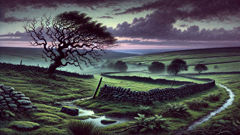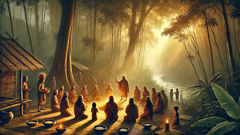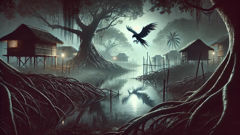Introduction
Mist lingers over the rolling green moors of Yorkshire, where sheep huddle close and ancient stone walls snake across the landscape like the lines on a weathered hand. In this corner of England, the land remembers: every hollow, every marsh, every crooked tree is heavy with the stories of those who came before. It is here, in the shadowed valleys and mossy fields, that the legend of the boggart has taken root, whispered in fireside tales and muttered behind closed doors when the wind howls down from the Pennines. The boggart, a spirit said to haunt farmhouses and moorland alike, is as old as the land itself. No one agrees on what a boggart truly looks like; some say it’s a squat, hairy creature with glowing eyes, others insist it is invisible, a presence felt more than seen—a cold shiver down the spine, the creak of a stair in the dead of night. One thing everyone agrees on: you never call a boggart by name, for names have power, and to name a boggart is to bind it forever to your hearth. Yet, for all their fear, the folk of Yorkshire have learned to live with their boggarts, making offerings of cream and bread, hanging horseshoes above doors, and whispering little charms to ward off mischief. In the 19th century, when the Industrial Revolution was beginning to gnaw at the edges of rural life, stories of the boggart remained—perhaps as a comfort, perhaps as a warning. For every new machine that clattered into the countryside, there was a tale of a plough breaking or a churn spoiling, blamed not on faulty gears but on the unseen hand of the boggart. This is a story drawn from that time, when the land was still wild, and the spirits that haunted it were as real as the morning fog. It begins with the Alderson family, who tended their sheep and watched over their little farm at the edge of Hagg’s Marsh. What befell them would pass into local legend, reminding all who heard it that the world is not as tame as we sometimes think, and that the boundary between seen and unseen is thinner than the mist that creeps across the moor at dusk.
The Shadow in Hagg’s Marsh
The Alderson farm sat at the edge of Hagg’s Marsh, a landscape more water than earth, where reeds swayed and ground mist curled along the banks of sluggish streams. The farmhouse, with its thick stone walls and thatched roof, had stood for centuries—older than memory, older even than the mapmakers’ lines. By the time Michael Alderson inherited the farm from his father, the tales of the boggart had become so woven into daily life that he hardly noticed them. They were background noise: his grandmother’s warnings, the charms tucked behind the pantry door, the little bowls of milk left out on moonless nights. Michael believed in hard work and good weather, not in spirits. His wife, Ellen, was more cautious. She kept her broom by the door and never whistled after sunset. Their children—Catherine, aged twelve, and little Tom, just turned eight—grew up listening to both their father’s practical sense and their mother’s quiet rituals. For a long while, life was simple. Sheep grazed, the chickens laid, and the land yielded what it always had. But one November evening, when dusk fell early and the marsh was thick with fog, Michael noticed something odd: a patch of ground near the edge of the marsh where nothing would grow, no matter how many times he tilled and seeded it. That night, as he sat by the fire rubbing his aching hands, Ellen mentioned she’d heard scratching behind the pantry wall. Not rats—something slower, deliberate. Catherine found her rag doll face down in the water trough the next morning, soaked through. Tom’s best marbles disappeared from their usual place on the hearth. At first, these were dismissed as tricks of memory or careless children. Yet the disturbances grew bolder. Milk soured overnight. Eggs cracked themselves in their baskets. The old clock in the hall chimed at odd hours, and a cold draught wound its way through the house even when every door was closed. Ellen began to grow pale, her eyes shadowed by worry. She whispered to Michael that perhaps they had a boggart. He snorted, but as the weeks passed and the troubles mounted, even he started to wonder. One night, after a particularly restless sleep, Michael awoke to find his boots filled with muddy water. The air in the room was so cold his breath smoked. He caught a glimpse in the looking glass—just for a second—of something hunched and squat, with long, hairy arms and eyes like lanterns, before it vanished into the dark. By morning, he’d almost convinced himself he’d imagined it. But when he stepped outside, he saw that the barren patch near the marsh had grown, creeping closer to the house. The next day, Michael rode to the village for advice. The landlord laughed at his tale; the blacksmith muttered about curses. But old Mrs. Wainwright, who sold herbs and whispered charms, listened closely. "There’s boggart-work afoot," she said. "You mustn’t name it. Never speak to it directly. Show respect—give it a gift. And if you anger it, you’ll never rid yourself of it, not even if you move house. Boggarts travel with those who wrong them." Michael returned home, troubled. That night, Ellen poured a bowl of cream and set it on the doorstep. Catherine sprinkled salt at each threshold. Tom, not quite understanding, placed his last marble on the windowsill. The house settled into uneasy silence. Outside, the mist thickened, and from the marsh came a low, rumbling laugh—a sound that would haunt their dreams for weeks to come.
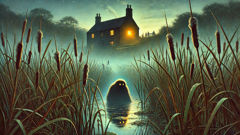
Whispers in the Walls
In the days that followed, the Aldersons tiptoed through their routines, wary of every creak and shadow. The boggart’s mischief escalated. Ellen found her bread dough ruined each morning, slashed with deep finger marks no human hand could have made. Tom’s toys were flung about the house, sometimes arranged in strange circles on the floor. Catherine began to hear whispers at night—a rustling under her bed, a low mutter in the walls, as if someone was telling secrets she wasn’t meant to know. Michael grew irritable, snapping at his family and throwing himself into work, hoping to ignore the problem out of existence. But the land itself rebelled. Fences collapsed in the night. Sheep went missing, only to be found days later cowering at the marsh’s edge, their eyes wide with terror. When Michael tried to fix the barren patch, his spade snapped in two. Even the dogs refused to go near the marsh after sunset. Desperation drove Michael to consult the vicar, who offered prayers but little comfort. “Sometimes,” the vicar admitted, “it’s best to make peace with what you can’t control. The old ways have their wisdom.” At home, Ellen doubled her efforts, laying out bread and honey, sweeping the thresholds thrice daily. Catherine read from her grandmother’s old book of charms by candlelight, searching for a way to banish the spirit or at least soothe its anger. One night, as rain lashed the windows and thunder shook the roof, Catherine crept downstairs, heart pounding. She felt drawn to the kitchen, where a cold draft tugged at her nightdress. There, at the hearth, she saw it—the boggart, hunched and shaggy, its eyes gleaming in the gloom. It looked at her with a mixture of mischief and sadness. "Why do you trouble us?" she whispered, careful not to say its name. The boggart didn’t speak but pointed a long, crooked finger at the window, towards the marsh. Catherine’s breath caught. She remembered old tales: boggarts, like people, sometimes carried grudges, often for wrongs forgotten by those who had wronged them. She slipped outside into the rain, following the creature’s gaze. In the marsh, she stumbled upon a patch of churned earth, half-covered by reeds. Digging with her bare hands, she uncovered an old iron horseshoe—rusted but still whole. Suddenly, the boggart was beside her, its face close to hers, and Catherine felt a chill that went straight to her bones. Yet she saw something in its eyes: longing, or perhaps loneliness. She placed the horseshoe upright in the ground and whispered a blessing she remembered from her grandmother. The boggart touched her hand—its touch icy and feather-light—then melted back into the mist. From that night on, the worst of the mischief eased. Milk soured less often. The whispers faded. Still, the family knew the boggart remained, watching from the shadows, waiting.
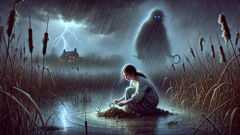
The Bargain and the Binding
Spring came late to Hagg’s Marsh that year. The snow lingered longer than usual, and when it finally melted, it left behind pools of stagnant water and tangles of dead grass. The Aldersons hoped the worst was over, but new troubles emerged. Tools vanished from the barn, only to reappear in impossible places—an axe atop the roof, a rake wedged into a willow tree. One morning, Michael found his reflection staring back at him from the bottom of the well, grinning with someone else’s smile. Rumors spread through the village. Some said the Aldersons were cursed. Others whispered that Michael had made a bargain with something from the marsh. Ellen’s health began to falter; she spent her days in bed, clutching a charm to her chest. Catherine and Tom did their best to keep up with chores. Despite everything, Catherine couldn’t shake the memory of her midnight encounter. She sensed that the boggart’s anger was rooted in something deeper—an old injustice, a forgotten promise. She scoured her grandmother’s book for clues. One passage caught her eye: “The boggart binds itself to those who cross its ground unjustly. To set it free or make peace, the wrong must be righted.” Catherine pieced together stories from neighbors. Decades earlier, before her family owned the farm, the marsh had been common land—a place where all were welcome to graze their sheep. A previous owner had driven off poor villagers and fenced in the land for himself. Perhaps this act had awakened the boggart’s wrath. One foggy morning, Catherine gathered her family in the kitchen. With trembling hands, she explained her theory. Michael, worn down by months of fear and misfortune, agreed to try anything. Together, they ventured into the marsh, carrying bread and honey as offerings. At the center of the barren patch, they knelt and spoke aloud a promise: to open their pastures to their struggling neighbors and share what they could with those in need. The wind died down. The mist parted, and for the first time in months, sunlight glimmered on the marsh water. A shape moved at the edge of their vision—a squat figure, its eyes no longer burning with malice but with something like gratitude. That night, they placed a new bowl of cream at the doorstep. The next morning, it was empty, licked clean. The house felt lighter. Ellen’s color returned, and laughter crept back into their days. The boggart’s mischief never vanished completely—it would always be part of life at Hagg’s Marsh—but it grew gentler, more playful than spiteful. The Aldersons understood at last: the boggart wasn’t just a creature of fear, but a keeper of memory and justice, bound to the land and those who called it home.
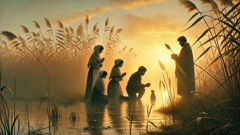
Conclusion
The tale of the Aldersons and their boggart lives on in Yorkshire lore. Even now, when mist settles thick over the moors and a chill wind rattles old windows, villagers remember to show respect for what cannot be seen. They leave small gifts by their doors and greet the marsh with a cautious nod. The boundary between the world of men and that of spirits is never far—sometimes it’s as close as a shadow in the corner of your eye or a laugh carried on the wind. For the boggart is both a reminder and a warning: nature holds memories long after people have forgotten, and justice—like the marsh mist—can seep through any crack. Yet there is comfort in knowing that with humility, kindness, and a willingness to share what we have, even the oldest grudges can be eased. The land and its legends endure, shaping those who listen and weaving them into something larger than themselves: a tapestry of wonder, fear, and hope that stretches across generations.

